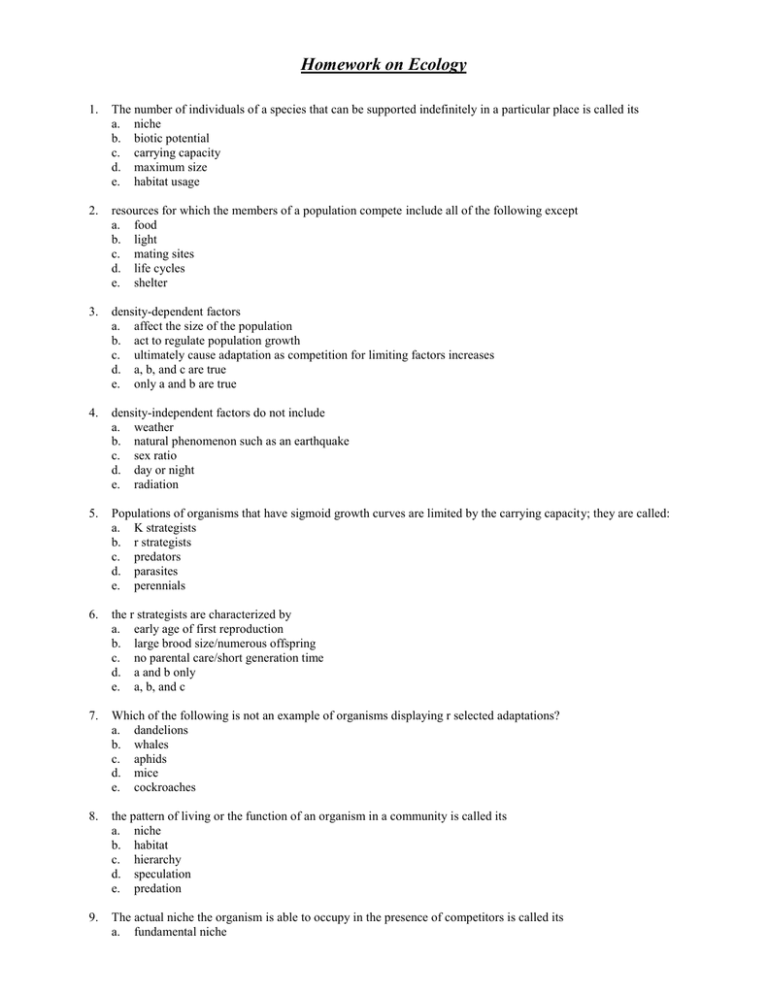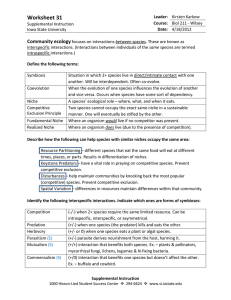Homework on Ecology
advertisement

Homework on Ecology 1. The number of individuals of a species that can be supported indefinitely in a particular place is called its a. niche b. biotic potential c. carrying capacity d. maximum size e. habitat usage 2. resources for which the members of a population compete include all of the following except a. food b. light c. mating sites d. life cycles e. shelter 3. density-dependent factors a. affect the size of the population b. act to regulate population growth c. ultimately cause adaptation as competition for limiting factors increases d. a, b, and c are true e. only a and b are true 4. density-independent factors do not include a. weather b. natural phenomenon such as an earthquake c. sex ratio d. day or night e. radiation 5. Populations of organisms that have sigmoid growth curves are limited by the carrying capacity; they are called: a. K strategists b. r strategists c. predators d. parasites e. perennials 6. the r strategists are characterized by a. early age of first reproduction b. large brood size/numerous offspring c. no parental care/short generation time d. a and b only e. a, b, and c 7. Which of the following is not an example of organisms displaying r selected adaptations? a. dandelions b. whales c. aphids d. mice e. cockroaches 8. the pattern of living or the function of an organism in a community is called its a. niche b. habitat c. hierarchy d. speculation e. predation 9. The actual niche the organism is able to occupy in the presence of competitors is called its a. fundamental niche b. c. d. e. realized niche interference niche intraspecific niche exploitative niche 10. competition between individuals of a single species is called a. interspecific competition b. exploitative competition c. interference competition d. fundamental competition e. intraspecific competition 11. animals defend themselves against predators by all of the following, except a. warning coloration b. cryptic coloration c. chemical defenses such as poisons and stings d. parasitism e. aposematic coloration 12. Some insects that lack any specific chemical defenses blend with their environment to avoid predators. This type of defense strategy is called a. batesian mimicry b. camouflage c. cryptic coloration d. warning coloration e. Muellerian mimicry 13. a symbiotic relationship in which both organisms benefit is a. parasitism b. mutualism c. commensalism d. tolerance e. predation 14. if in a relationship the organism growing on the host benefits, and the host is unharmed, the relationship is called a. parasitism b. mutualism c. commensalism d. tolerance e. predation 15. coevolution is based on a. competition b. mimicry c. natural selection d. symbiosis e. chemical defenses 16. communities evolve to have greater biomass and species richness in a process called a. symbiosis b. higher productivity c. spatial heterogeneity d. predictability e. succession






